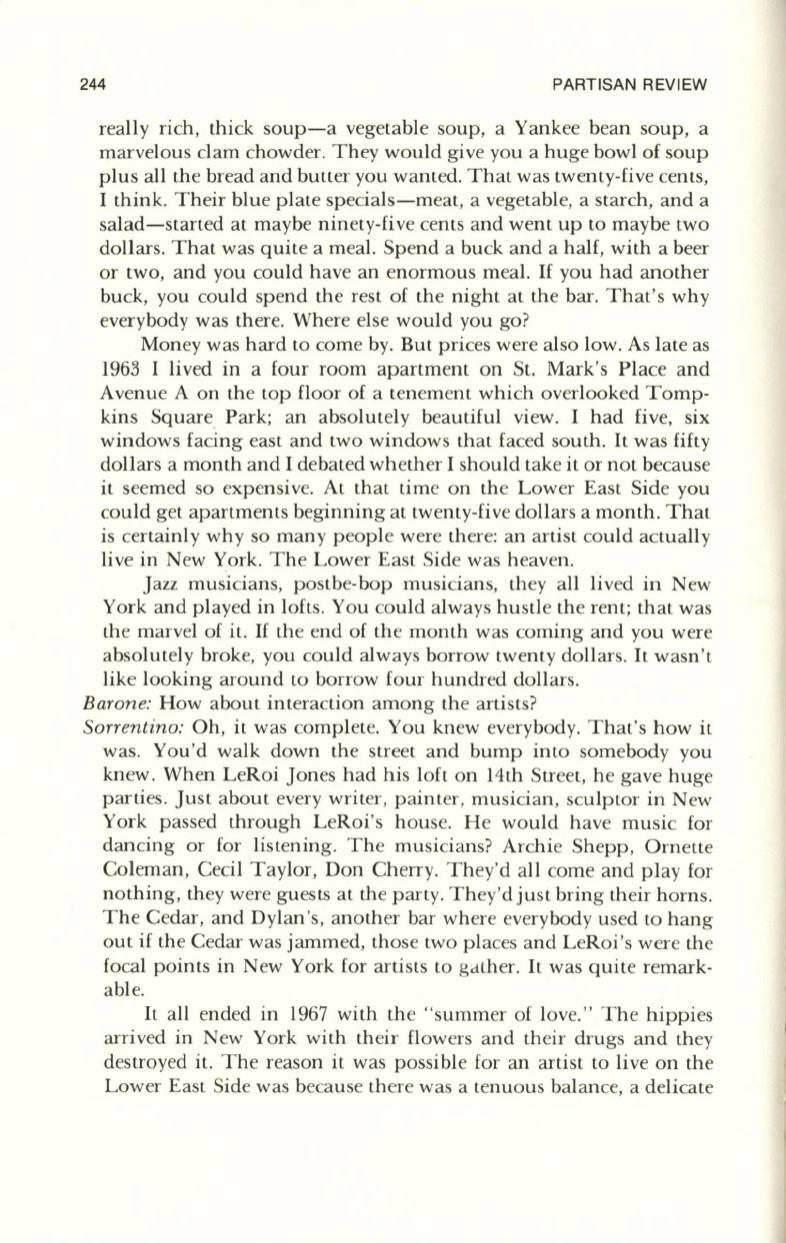
244
PARTISAN REVIEW
really rich, thick soup-a vegetable soup, a Yankee bean soup, a
marvelous clam chowder. They would give you a huge bowl of soup
plus all the bread and butter you wanted. That was twenty-five cents,
I think. Their blue plate specials-meat, a vegetable, a starch, and a
salad-started at maybe ninety-five cents and went up to maybe two
dollars. That was quite a meal. Spend a buck and a half, with a beer
or two, and you could have an enormous meal.
If
you had another
buck, you could spend the rest of the night at the bar. That's why
everybody was there. Where else would you go?
Money was hard to come by. But prices were also low. As late as
1963 I lived in a four room apartment on St. Mark's Place and
Avenue A on the top floor of a tenement which overlooked Tomp–
kins Square Park; an absolutely beautiful view. I had five, six
windows facing east and two windows that faced south. It was fifty
dollars a month and I debated whether I should take it or not because
it seemed so expensive. At that time on the Lower East Side you
could get apartments beginning at twenty-five dollars a month. That
is certainly why so many people were there: an artist could actually
live in New York. The Lower East Side was heaven.
Jazz musicians, postbe-bop musicians, they all lived in New
York and played in lofts. You could always hustle the rent; that was
the marvel of it.
If
the end of the month was coming and you were
absolutely broke, you could always borrow twenty dollars.
It
wasn't
like looking around to borrow four hundred dollars.
Barone:
How about interaction among the artists?
Sorrentino:
Oh, it was complete. You knew everybody. That's how it
was. You'd walk down the street and bump into somebody you
knew. When LeRoi Jones had his loft on 14th Street, he gave huge
parties. Just about every writer, painter, musician, sculptor in New
York passed through LeRoi's house. He would have music for
dancing or for listening. The musicians? Archie Shepp, Ornette
Coleman, Cecil Taylor, Don Cherry. They'd all come and play for
nothing, they were guests at the party. They'd just bring their horns.
The Cedar, and Dylan's, another bar where everybody used to hang
out if the Cedar was jammed, those two places and LeRoi's were the
focal points in New York for artists to gdther.
It
was quite remark–
able.
It all ended in 1967 with the "summer of love." The hippies
arrived in New York with their flowers and their drugs and they
destroyed it. The reason it was possible for an artist to live on the
Lower East Side was because there was a tenuous balance, a delicate


